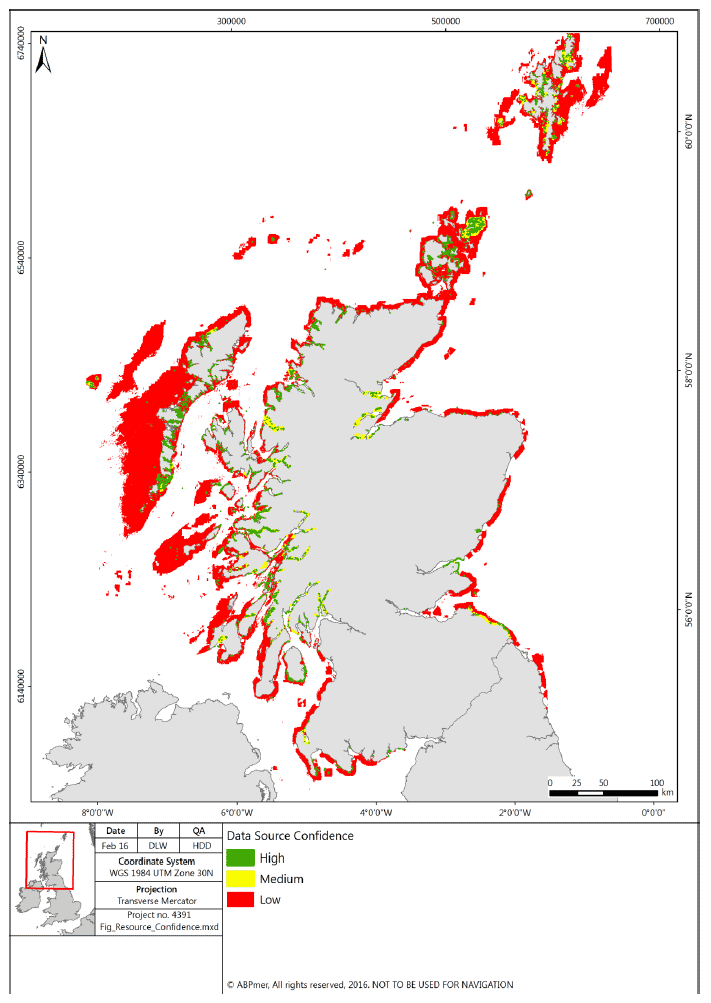Wild seaweed harvesting: strategic environmental assessment - environmental report
Investigates the sustainability and potential environmental impacts of wild seaweed and seagrass harvesting, maerl extraction and removal of beach-cast seaweed.
14. Appendix A: Spatial Data
14.1. Spatial Data used in the preparation of this SEA
14.1.1. These maps are based on the latest available spatial data, namely:
- Geodatabase of Marine Features in Scotland ( GeMS);
- EMODnet fine, medium and broad scale EUNIS habitat layers;
- OSPAR threatened and/or declining habitats;
- EUSeaMap predictive EUNIS habitat layers; and
- Burrows et al. (2014a) kelp suitability layers.
14.1.2. EUSeaMap was used to provide an underlying basemap of predicted broadscale habitat types likely to support relevant seaweed and seagrass groups. This information was then overlaid with predictive information on suitable kelp habitat from Burrows et al. (2014a) to characterise potential areas of kelp. The distribution maps were then further refined with the relevant fine, medium and broad scale EUNIS habitat information and OSPAR threatened and/or declining habitats from EMODnet. Records from GeMS were then overlaid to add detail to the distribution maps and confirm the presence of seaweed and seagrass features.
14.1.3. Other seaweed and seagrass survey and mapping data do exist in Scotland. However, there has been no co-ordinated survey of the distribution and abundance of either seaweeds or seagrasses in Scotland. A significant large scale survey of the seaweed resources of Scotland was undertaken by the Scottish Seaweed Research Association in the 1940s (Walker, 1947). However, this dataset has not been digitised and was therefore not readily available for use within the timescale for this study.
14.1.4. A confidence level of high, medium or low has been assigned to each map layer according to the resolution and origin/nature of the underlying spatial data (Table A1). Any seaweeds or seagrasses that have been mapped and overlap, for example areas that have been assigned a low confidence, are based on predicted data and/or broad scale mapping information.
Table A1 Criteria used to assign confidence level to data sources
| Confidence Level |
Criteria |
|---|---|
| High (H) |
Spatial data layers that are based on survey records and/or fine-scale mapping information ( i.e. MESH records and MESH fine-scale habitats). |
| Medium (M) |
Spatial data layers that are based on medium-scale mapping information ( i.e. MESH medium-scale habitats). |
| Low (L) |
Spatial data layers that are based on predicted ( i.e. modelled) data because they have not been validated (ground-truthed) and/or broad-scale mapping information ( i.e. MESH broad-scale habitats, Burrows et al. (2014a) predictive kelp layers and EUSeaMap broad-scale habitats). |
14.1.5. The confidence level assigned to the combined distribution of seaweeds and seagrasses is shown in Figure A1
Figure A1: Level of confidence in the combined mapped distribution of seaweeds and seagrasses in Scotland

Contact
There is a problem
Thanks for your feedback